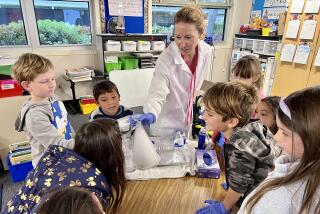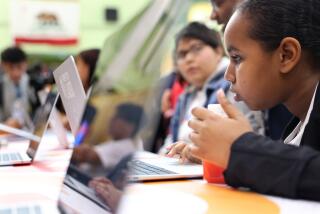Teachers Point, Click Way to New Methods
- Share via
IRVINE — Patricia Lawrence is sketching the future of mathematics teaching on a giant color monitor, pointing and clicking in rapid sessions of Math Blaster and Geometric Golfer.
She launches a green android from a lunar landscape to tag the correct answer to an arithmetic problem. She swings a golf club to whack a quadrilateral across a video fairway on the x and y axes.
In this workshop on educational software, the pupils themselves were teachers. More than 200, mostly from elementary schools, came to UC Irvine on a drizzly Saturday to find new ways to stimulate Orange County’s brightest kids.
Technology was the day’s hottest topic. Public schools are constantly adding the latest gadgets--computers, software, laser discs, video cameras and Internet ports--to their educational tool kits.
The conference explored teaching methods for the top 5% of Orange County children, identified through tests as gifted and talented. But it also underscored dramatic changes in learning throughout public schools. At its best, educators say, new classroom technology enables students to become teachers themselves.
“It will never replace a classroom with a person in charge,” said Lawrence, a program specialist for gifted education at the Santa Ana Unified School District. “But how the teacher acts is what makes a difference. Technology can help replace passive learning with the active learning of doing and student involvement.”
*
This year, UC Irvine is offering its first course in online teaching skills. Joan Bissell, the lecturer in charge, said many local teachers are clamoring to learn how to navigate the World Wide Web. She said about 80 have enrolled in Education 173: Learning Theories and Classroom Practice Online.
“Teachers and administrators want to know how to do it, and they’re moving ahead very rapidly. It’s the dawn of a new era,” Bissell said. “We are literally at the takeoff point. Things are beginning to happen on a scale where there’s visible impact.”
The fruits could be seen in a campus computer laboratory Saturday, where teachers were shown how to write commands for search engines, with such names as Yahoo and AltaVista, to extract the most useful educational pages from the Web.
Linda Heath, a sixth-grade teacher at Deerfield Elementary School in Irvine, entered “ancient cultures” and turned up essays on Indian, Chinese and other civilizations. She scrolled through one titled “The Status of Women in Ancient Egyptian Society.”
“Many of my kids probably have Internet access at home. If I gave them this, they’d be able to use it,” Heath said. “I’m always getting kids who list the Internet in their [report] bibliographies.”
Of course, many Orange County students have no computer at home, let alone an Internet account. But educators said Deerfield and other schools are getting wired as quickly as possible. Lawrence said Santa Ana Unified, the county’s largest district, has obtained a grant this year to install Internet links on every campus through television cables.
*
Many of the most creative new uses of classroom technology don’t require a modem. Teachers told of students who use video cameras and CD-ROM encyclopedias to prepare reports.
Hall Davidson, the director of education television services at KOCE-TV Channel 50, a public station in Huntington Beach, showed off a 10-minute video report on the Holocaust prepared by two local elementary students who interviewed survivors and used footage from the World War II era.
Doug Chapman, a fourth-grade teacher at Benjamin Beswick Elementary School in Tustin, said he routinely dispatches one or two students to computer terminals at the back of a classroom to play with math-building software--like the popular Math Blaster--while the rest of the class is busy with a social studies or science assignment.
Many schools lack the money to buy the latest equipment. So teachers chip in. Chapman said he recently bought a CD-ROM kit for $30 called “Explorers of the New World” that he plans to use in his social studies lessons.
“There is not a teacher anywhere that has not pulled money out of his or her pockets for something like this,” he said. “It can get expensive.”
Not all teachers are enthusiastic. Like parents, many teachers know far less about the new technology than the kids themselves. There is little data to show that installing computers and school Internet accounts will yield higher test scores. And some things, such as dissecting a frog, are still best done live.
But Davidson said technology can unlock the learning potential of many kids whose eyes glaze in front of a chalkboard.
“The reward is that you have students who will shine in ways that they otherwise wouldn’t be able to shine,” he said. “New tools do not necessarily teach better. But teachers have to recognize that this may be a chance worth trying.”
More to Read
Sign up for Essential California
The most important California stories and recommendations in your inbox every morning.
You may occasionally receive promotional content from the Los Angeles Times.










